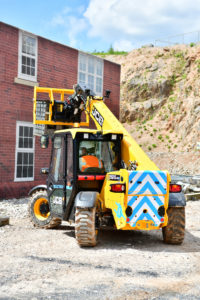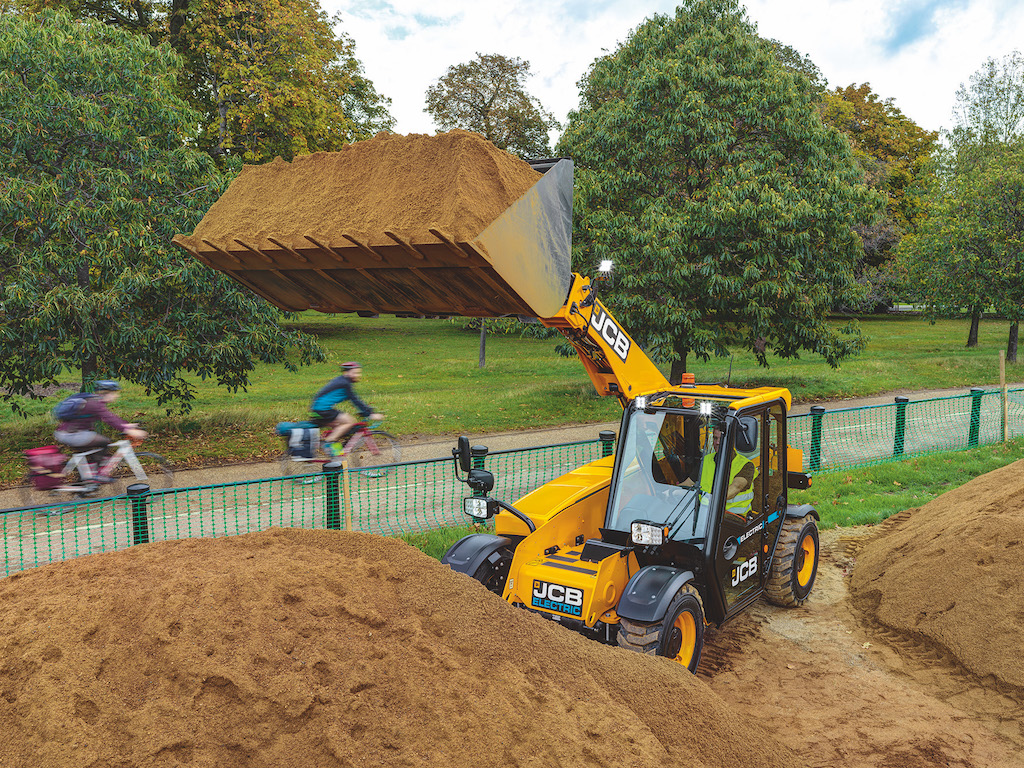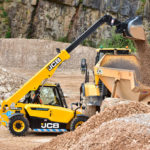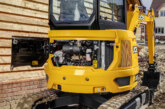JCB continues to charge on with its battery-powered solutions, including a new Loadall option.
JCB has taken a lead in the increasingly rapid move towards an electric future, with the launch of a range of E-Tech models, powered exclusively by batteries. This includes a mini excavator, a Teletruk industrial fork lift, a range of access platforms, a tracked dumpster, site dumper and more recently a Loadall telescopic handler.
 Electric capacity
Electric capacity
The 525-60E is based on the existing diesel-powered 525-60 Loadall, with the promise of identical lifting capacities and performance, but without a diesel engine under the canopy. The machine has a maximum lift capacity of 2.5-tonnes and a maximum lift height of 6.0m. It offers a 2.0-tonne lift capacity at full height and a 720kg lift capacity at its maximum 3.5m forward reach.
In place of the engine is a 24kWh lithium-ion battery pack. This powers a 96V electrical system, that the manufacturer claims will meet the daily needs of around 95 per cent of Loadall customers at this machine size. A motor controller takes the DC charge from the lithium-ion batteries and converts it to alternating current, which is sent to two separate electric motors.
There is a 17kW traction motor, that drives through a four-wheel drive dropbox to the drive/steer axles. Though similar to the axles on the diesel model, the electric machine has reduced disc brake capacity, as the electric motor delivers regenerative braking, charging the battery. Having fewer brake discs reduces drag on the motor, saving battery power.
There is a second 22kW electric motor, for the boom functions, with an 80 litre/min fixed displacement gear pump supplying the hydraulic power. This makes it possible to lift and extend the boom while independently powering the wheels. The drive to the hydraulic pump is only activated when the operator moves a lever for boom functions, reducing the electrical energy required to power the hydraulic system. In addition, the machine regenerates flow as the boom is lowered, reducing the energy required to power the hydraulic system.
Charging times
The 525-60E has a 3kW on-board charger, capable of fully charging the battery in 8 hours, through a domestic 230/240V electrical supply. This uses a typical blue site connector in the small charging port ahead of the right-hand rear wheel. There is also the option of using the JCB Universal Charger, where three-phase 415V power is available. This can charge the machine in around 90 minutes.

Performance and productivity
As with electric road vehicles, maximum torque is available straight away, which means the compact Loadall reacts instantly to operator inputs. That said, you can smoothly creep forward while placing a load, or when positioning forks under a pallet. There is a foot brake pedal in the cab but lifting off the drive pedal results in regenerative braking, so there is rarely a need to use it.
As with the diesel machine, the 525-60E can be operated with pallet forks or a range of attachments. The instant torque delivery makes it easy to dig into a pile of material when equipped with a bucket.
Operator control
The ROPS/FOPS cab is identical to the diesel model, other than some slightly different graphics in the main dash screen, where engine rpm has been replaced by a battery symbol to show remaining charge. The fully glazed cab has a 2.2kW electric heater, along with heated front, side and rear screens for rapid defrosting in the mornings.
The operator also gets a heated suspension seat and visibility is very good, as the electric drive has been installed within the existing bodywork. The machine is equipped with JCB’s Adaptive Load Control System with A-pillar mounted screen, for maximum lift safety. Noise levels in the cab are just 66.7dB, while externally the machine creates 92.2dB. A white noise reversing alarm is an option, to warn other site operatives that the machine is in use.
Total cost of ownership
Much like electric cars, the 525-60E is initially more expensive than the diesel model. But, overall running costs could be considerably lower, depending in part on your source of electricity. Service and maintenance costs will be far lower too, as there is no engine oil, no fuel or air filters and less use of the service brake, leading to longer life. The batteries are maintenance-free.
Perhaps more importantly, there are sites where a lack of engine emissions and to a lesser extent noise, will be very welcome. Contractors working in an underground operation or rail tunnel, will be able to operate without costly exhaust extraction equipment for instance. There will be plenty of urban sites where the lack of noise and fumes could allow longer working hours too, particularly in residential areas.
As with all Loadall telehandlers, the 525-60E can be supplied with JCB’s LiveLink telematic system, providing managers with real-time operating information. This includes battery charge levels and charging times, along with location data, service reminders and remote diagnostics capabilities.
Tomorrow’s machinery today
JCB freely admits that the 525-60E won’t suit every single application. No-one is claiming that electric drive will be the only solution to the problems of air quality and climate change that are affecting countries across the world. It will play a part in a range of driveline solutions.
However, the machine could meet the needs of around 95 per cent of today’s customers and that is more than enough to start a quiet revolution on construction sites and in agricultural yards. It is also worth remembering that this is only JCB’s first electric Loadall, with the engineers and designers able to select the 525-60 as the ideal starting point. This compact Loadall has the widest customer base, covering construction and agriculture and can now be offered with a zero-emission solution to a wide spread of industry sectors. As battery technology develops, there is little doubt that JCB will remain at the forefront of this exciting new industry sector.









